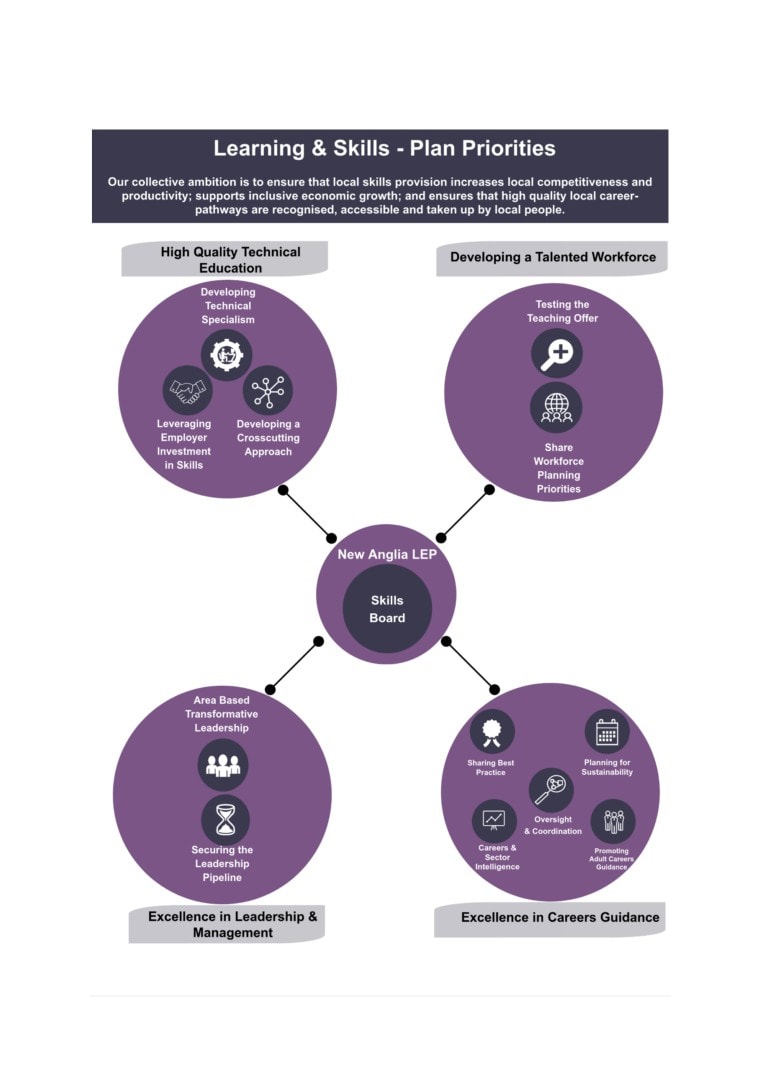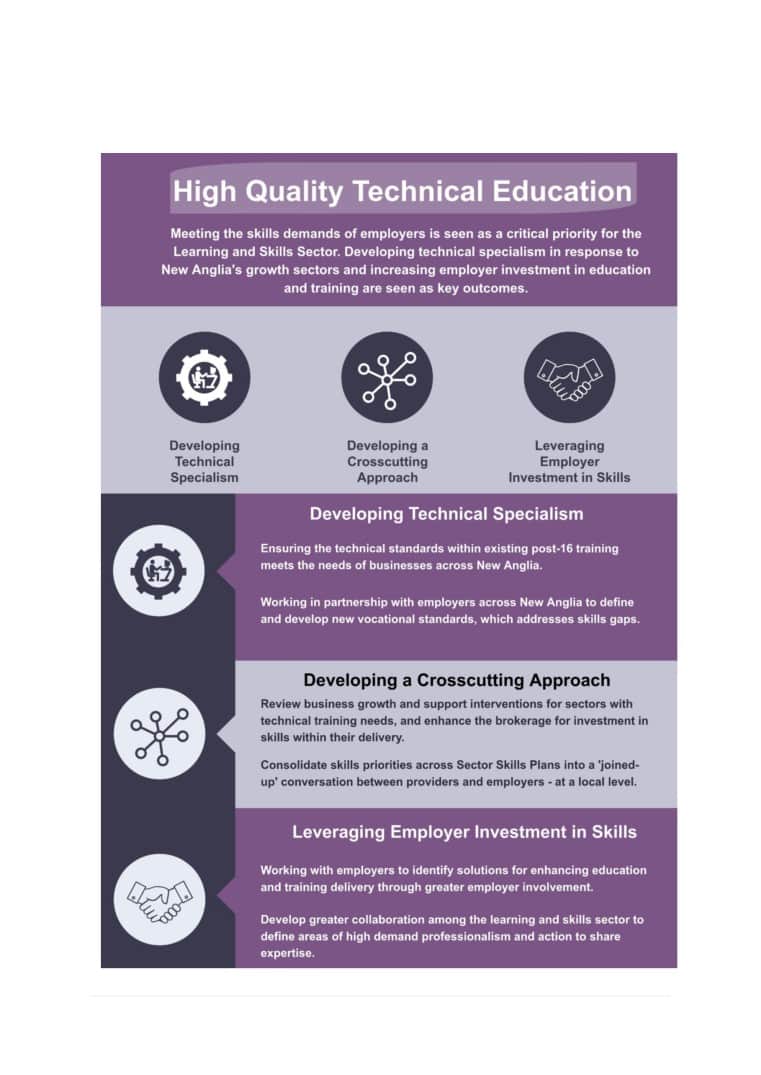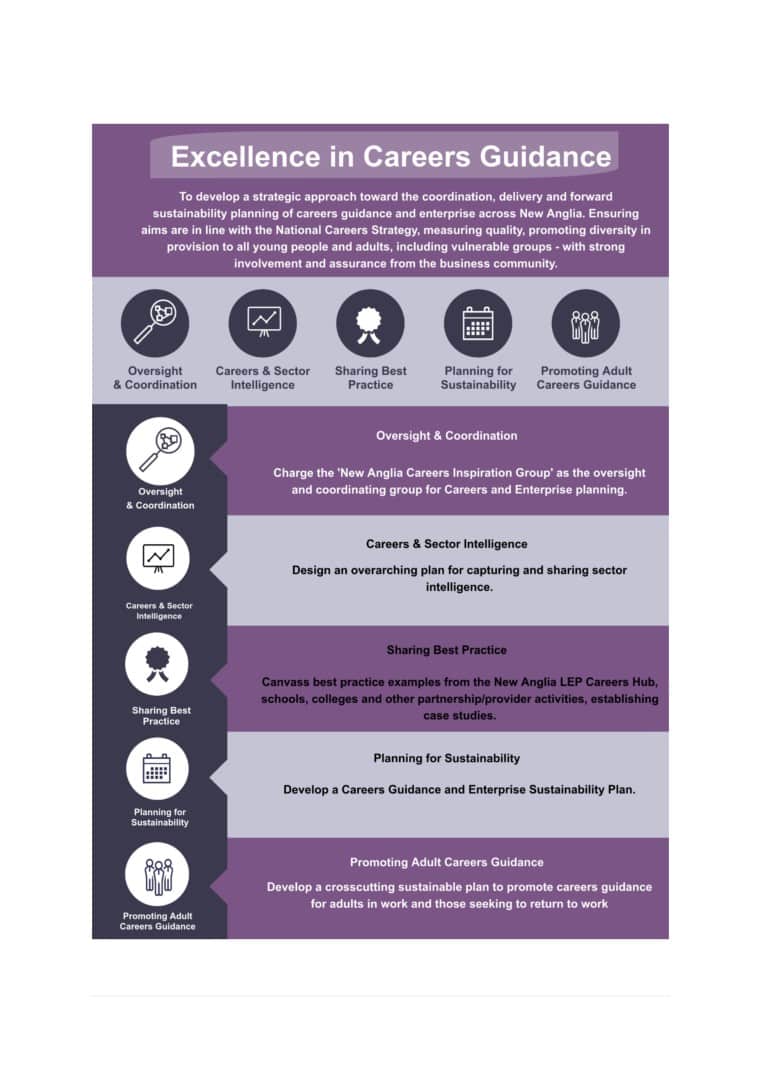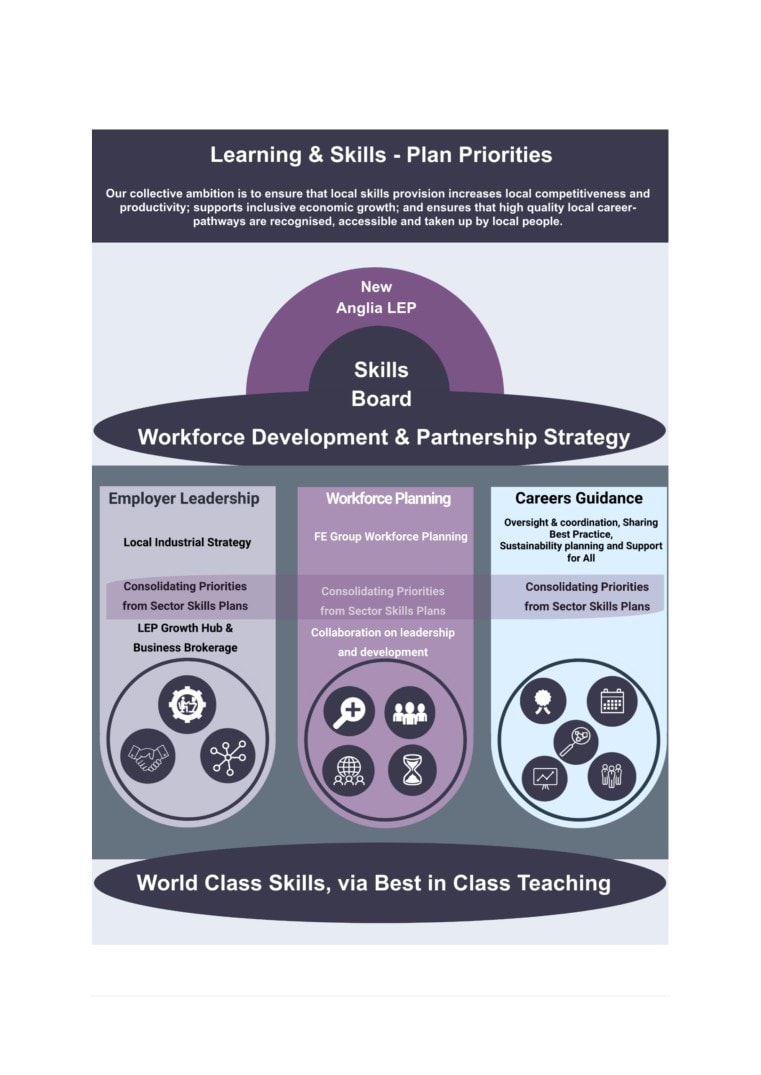LEARNING AND SKILLS
SECTOR
SKILLS PLAN
Skills Board endorsed version
Putting skills at the heart of building
a competitive and sustainable
local economy
March 2019
1 | P a g e
Background Context
The Learning and Skills Sector Skills Plan has been developed with the sector in Norfolk and
Suffolk, working alongside the New Anglia Local Enterprise Partnership, the New Anglia
Skills Board and supported by SkillsReach.
SkillsReach was contracted to facilitate and prepare eight sector skills plans for the New
Anglia LEP priority sectors. The project was commissioned by the Education and Skills
Funding Agency, in partnership with New Anglia LEP, and funded through the European
Social Fund. Each Sector Skills plan and supporting Data Pack has been developed in
collaboration with local employers and other stakeholders.
The New Anglia Skills Board places employers at the centre of decision making on skills in
Norfolk and Suffolk to ensure the skills system becomes more responsive to the needs of
employers, residents and the future economy.
SkillsReach is an established East of England-based strategic skills consultancy with an
associate project team with extensive experience of developing skills plans.
2 | P a g e
Executive Introduction
‘Welcome to the Learning and Skills Sector Plan for New Anglia. It sets out our
collective vision for how local skills provision can increase local competitiveness and
productivity, support inclusive economic growth and ensure that high quality local
career-pathways are recognised, accessible and taken up by local people.
This plan is a key step in the development of a regional collaboration between
business, localities and skills providers to ensure inclusive growth, and that skills
opportunities are connected and maximised for businesses and local residents.
We look forward to making an increasing and sustainable contribution to the future of
our vibrant New Anglia Economy’.
Signed……
Corienne Peasgood
Principal, City College, Norwich
3 | P a g e
Contents
Executive Introduction
3
1 Learning and Skills Sector Skills Plan- the Key Priorities
5
Challenges and Opportunities
6
Proposed Skills Interventions
11
Partnership Strategy
25
2 The Learning and Skills Sector in Context
26
Defining the Learning and Skills Sector
28
Routes into Learning and Skills Careers
29
3 Stakeholder Feedback
31
Developing Technical Specialism
31
Developing a Cross-cutting Approach
32
Leveraging Employer Investment in Skills
34
Future Proofing Technical Expertise
34
Vacancy Filling and Workforce Development
36
Apprenticeships
36
HE- Talent Retention
37
Employment Demand & Future Forecasting
37
Key Workforce Challenges- Summarised
38
Leadership and Management in the Learning and Skills Sector
39
Supporting Careers Leadership and Delivery
41
Appendix A- Skills Plan Development Process
46
List of Consultees
48
4 | P a g e
1 Learning and Skills Sector Skills Plan- the Key Priorities
5 | P a g e
Challenges and Opportunities
The data analysis and qualitative consultation (detailed in the subsequent chapters in this
report) have enabled an evidence base to be developed that captures and defines a range
of issues and risks linked to the demand and supply of skills for the Learning and Skills
sector in New Anglia. In contrast, there are a range of strengths and major opportunities to
position the skills plan against, giving planned interventions real momentum moving ahead.
The consultation has highlighted four key priorities of action for the skills plan to address:
1. High Quality Technical Education
Government policy for post-16 vocational education has positioned technical reform
as an overarching priority, with skills seen as a major contributor for developing world
leading competitiveness in the UK’s economy. Alongside this is a growing
expectation from employers to benefit from high quality vocational training,
underpinned with high quality, fit for purpose, technical standards. Both the Industrial
Strategy and the Post-16 skills reform position ‘localism’ as providing the catalyst for
these changes.
There remain however fundamental challenges. Recruitment into the Learning and
Skills sector can be difficult for specific teaching roles, particularly for high demand
subjects and areas of training and education that require niche/specialised skills.
The sector has highlighted the challenges of maintaining technical expertise in
response to vocational skills reform: encouraging ex-industry specialism into high
priority areas such as engineering, advanced manufacturing and digital skills, with
wage rates cited as a major barrier.
Furthermore, leadership and investment from industry is imperative for the supply of
current and future skills to be resilient and valuable in terms of building
competitiveness in New Anglia’s economy. The Learning and Skills sector recognises
there needs to be enhanced collaboration and planning as a ‘sector community’ and
extra emphasis on aligning skills with employer leadership, business investment and
growth within local economic strategy.
The first key aim of the New Anglia Learning and Skills Sector Skills Plan is to
work collaboratively, as a learning and skills community and together with
partners including the New Anglia LEP, to develop the effective level of
leadership and investment needed from employers, for high quality technical
education to be secured and sustained.
The first key outcome of the New Anglia Learning and Skills Sector Skills Plan
is that local employers benefit from world class, technically excellent training;
enabling the acquisition, utilisation and ongoing development of skills.
6 | P a g e
2. Developing a Talented Workforce
The Learning and Skills sector in New Anglia experiences relatively high levels of
unfilled and hard to fill vacancies, compared to both regional and national averages.
The sector also experiences organisational concerns regarding the utilisation and
level of proficiency of staff - again higher than local and national averages for all
sectors. The concerns relating to underutilisation and proficiency are partly driven by
teaching professionals having to respond to dual/multi-professionalism subject
delivery and a balance of responsibilities aligned with teaching and individual learner
support (SEND for example). Whilst the focus within this plan is set out against a
scope of post-16 education and training, with an emphasis on technical skills there
are wide variations of training needs within learning and skills teaching and delivery.
For example, a lecturer in engineering with strong links to industry compared to a
tutor in foundation learning or A-Level academic delivery. This impacts on diversity of
needs linked to labour market information, building workforce resilience and
responding to external demands.
There are however structural, labour market, challenges linked to the flow of talent
and availability of suitably qualified teaching professionals in line with current and
forecast demands. The Learning and Skills sector recognises the need to test the
teaching offer for the key sectors defined as being most important for New Anglia’s
growth and competitiveness. In addition, the sector is keen to share and collaborate
on action linked to workforce planning, the development of niche expertise and
marketing careers within learning and skills in New Anglia.
The second key aim of the New Anglia Learning and Skills Sector Skills Plan is
to develop collaborative workforce development planning processes for the
Learning and Skills sector across New Anglia. Joint planning will enable
providers to define common workforce priorities in response to external
education and training demands and labour market challenges. Furthermore, it
will provide ongoing options for managing risks, building organisation
resilience and sharing expertise.
The second key outcome of the New Anglia Learning and Skills Sector Skills
Plan is a resourceful and resilient New Anglia learning and skills sector that
continues to work proactively to ensure it is adaptable to change; ensuring
education and training delivery is of a high standard and responsive, with a
well organised and highly professional workforce.
3. Excellence in Leadership and Management
The Learning and Skills sector recognises that the development of management
skills and securing the leadership pipeline for senior roles is a major challenge overall
and one that builds internal resilience and effective external ‘whole system’
collaboration on learning and skills. There are examples in New Anglia of how
leadership development is being coordinated across several group-based
approaches: from early years through to FE and HE, with several key sectors also
including strong industry linked partnerships. There are also a range of interactions
7 | P a g e
and sponsorships aligned to the Education and Training Foundation’s ongoing
leadership development programmes.
The Learning and Skills sector is keen to develop further area-based leadership
collaboration. This would be aimed at addressing system wide leadership challenges
and informal peer-support arrangements looking at transformative initiatives aimed at
developing leadership by working across the civic, voluntary and private sectors.
The third key aim of the New Anglia Learning and Skills Sector Skills Plan is to
design and share across all years’ education in New Anglia, a collaborative
plan for management and leadership development. The plan will organise
activity aimed at promoting how education leadership can be developed via
local, external, transformative challenges and internal best practice in
management development.
The third key outcome of the New Anglia Learning and Skills Sector Skills Plan
is that the learning and skills sector in New Anglia benefits from talented
managers and leaders, with its workforce effectively supported and education
delivery to a high standard, and with communities benefitting from supportive
local leadership.
4. Excellence in Careers Guidance
Since the implementation of the new National Careers Strategy in 20171 and the
establishment of the national Careers and Enterprise Company (CEC), schools and
colleges are encouraged to take a more proactive and strategic approach towards
careers and enterprise delivery in order to equip the next generation of school and
college leavers with the appropriate employability and enterprise development that
employers will value. OFSTED will expect to see evidence on how independent
careers guidance is provided in schools to all year 8-13 pupils (12-18-year olds) and
that it must be provided in an impartial manner.
Both Norfolk and Suffolk County Councils take a strategic approach toward the
planning and provision of careers guidance, emphasising important issues linked to
the quality of delivery across all ages and assessing the capacity to deliver
interventions for a diverse range of needs, including via SEND provision and support
for NEETs. In addition, New Anglia LEP leads a network of Enterprise Advisers
(EAN), that works in partnership with Norfolk and Suffolk County Councils and the
National Careers Service (operated by Futures) to develop a joined-up response to
the National Careers Strategy. The EAN has a focus on supporting Gatsby
Recommendations as a measure but also takes a broad focus on key issues aligned
to the Careers Strategy. These include access to and delivery of Careers Leader
training (funded via DfE and controlled via the CEC, with Suffolk County Council one
of the formally approved providers) and the overall sharing of best practice across
the school and college network. Furthermore, the strategic focus taken by Norfolk
and Suffolk County Councils covers the planning of action that includes effective
provision of advice and guidance, with effective interventions, for young people with
Special Education Needs (SEND) and those that are either at risk of or are seen to
1 Careers Strategy- Making the Most of Everyone’s Skills and Talents (2017), DfE
8 | P a g e
be Not in Education, Employment or Training (NEET). New Anglia was one of the
successful LEP areas to win a share of the extra £5 million investment the
government has ringfenced to further promote the adoption of careers and enterprise
activity linked to the national strategy- via Careers Hubs.
Several key issues linked to developing excellence in careers guidance have been
identified via the consultation: ensuring existing resources are used effectively,
recognising the importance of area-wide collaboration and planning and ensuring that
careers guidance is developed strategically through a comprehensive approach. Four
key thematic opportunities have been identified:
Establishing effective oversight and coordination - of careers and
enterprise planning and intervention across New Anglia.
Testing and Effective Use of Labour Market Intelligence - both careers
and enterprise leads within Norfolk and Suffolk County Councils have
advocated for ongoing measures to test the relevancy, accuracy and quality
of labour market intelligence with employers and schools.
Promoting Best Practice - encourage the promotion of best practice in
delivery that can showcase initiatives that both inform the Careers Hub and
can be disseminated to schools and colleges across the whole of New Anglia.
Planning Sustainability - there are three key challenges in terms of
addressing sustainability for effective careers and enterprise guidance are:
• Funding and resources beyond 2020 that provide ongoing CPD for the
careers guidance community and can build on ‘operational’ initiatives
such as the Careers Hub.
• Promoting collaboration and ongoing alignment of partnership and
organisation activity against a strategic overarching focus for New
Anglia, which can create a shared vision and set of outcomes; and
can maximise efficiency through effective collaboration.
• Developing a framework of quality assurance that can consider how to
effectively baseline the capability of delivering effective careers
guidance across all years’ education and training, including provision
of excellent careers guidance specific to the needs of SEND, NEETs
and other vulnerable groups.
Taking a Strategic Approach Towards Careers Advice and Guidance for
Adults- stakeholders have raised concerns regarding the paucity of strategic
focus via the National Careers Strategy regarding advice and guidance
available for adults. This effects people in work looking to progress, move
jobs and plan career changes and adults looking to enter employment.
The fourth key aim of the New Anglia Learning and Skills Sector Skills Plan is
to develop a strategic approach toward the coordination, delivery and forward
sustainability planning of careers guidance and enterprise across New Anglia.
Ensuring aims are in line with the National Careers Strategy, measuring quality,
promoting diversity in provision to all young people and adults, including
9 | P a g e
vulnerable groups - with strong involvement and assurance from the business
community.
The fourth key outcome of the New Anglia Learning and Skills Sector Skills
Plan is that young people and adults benefit from effective career’s guidance
and enterprise initiatives, ensuring they make informed choices regarding
ongoing learning and careers options, develop valuable employability skills
and make positive progressions into work and economic independence.
10 | P a g e
Proposed Skills Interventions
11 | P a g e
Priority 1- High Quality Technical Education
Recruitment into the learning and skills sector can be challenging, particularly for
high demand subjects and areas of training and education that require
niche/specialised skills. The sector has highlighted the challenges of maintaining
technical expertise in response to vocational skills reform: encouraging ex-industry
specialism into high priority areas such as engineering, advanced manufacturing
and digital skills, with wage rates cited as a major barrier.
Furthermore, leadership and investment from industry is imperative for the supply
of current and future skills to be resilient and valuable in terms of building
competitiveness in New Anglia’s economy. The Learning and Skills sector
recognises there needs to be enhanced collaboration and planning as a ‘sector
community’ and extra emphasis on aligning skills with employer leadership,
business investment and growth within local economic strategy.
Key Aims and Outcomes:
To work collaboratively, as a learning and skills community and together with
partners including the New Anglia LEP, to develop the effective level of leadership
and investment needed from employers, for high quality technical education to be
secured and sustained.
The outcome of which - local employers benefit from world class, technically
excellent training; enabling the acquisition, utilisation and ongoing development of
skills.
Action to be Taken:
Three long term areas of action should be developed under the auspices of the Skills
Board, these are:
i)
Developing technical specialism by ensuring the technical standards
within existing post-16 training meets the needs of business across New
Anglia. This would involve a gap analysis assessing how New Anglia’s specific
skills priorities that are reliant on technical specialism, are currently supported
with up to date technical standards, accessible through local skills provision.
Gaps in standards or out of date standards risk creating skills supply shortfalls.
A process of assessing standards would need to include remedial action -
planning for the definition of new standards via local employer-led sponsors
and working with government to deliver accredited outcomes. (Developing
specialism within teaching is captured in Priority 2)
ii)
Developing a Crosscutting Approach - enhance the business growth and
support interventions for employers with technical training needs, by reviewing
how skills and training is effectively brokered. A key starting point would be
assessing how the LEP’s Growth Hub and LEP commissioned business
support provision can effectively broker employer investment in skills alongside
12 | P a g e
other recommended action. The Skills Board should be consulted on how
productivity and growth advice and guidance correlate to skills and training,
helping business support to clearly articulate the business case for skills when
advising local businesses. In addition, local training providers are keen to
develop a regular ‘skills conversation’ with businesses at an area level. The
Skills Board should consider how a cross-sector local skills event can help
training providers develop their employer offer and raise the profile of skills
solutions, with employers.
iii)
Leveraging Employer Investment in Skills- The New Anglia LEP should
encourage skills leaders to work with them to review how commitments around
investment in skills- both in terms of training/upskilling and other resources
(trainer support, input on quality assurance and donation of kit/equipment) can
be most effectively promoted across the range of business support funding
processes that are currently accessible. This may involve lobbying
policymakers nationally to promote greater focus on skills as part of any grant
funding frameworks. In addition, niche technical professionalism should be
identified through R&D, investment and grant based support activities; and
employers should be encouraged to work with the learning and skills sector to
develop technical excellence in teaching and training.
13 | P a g e
Priority 2- Developing a Talented Workforce
The Learning and Skills sector in New Anglia experiences relatively high levels of
unfilled and hard to fill vacancies, compared to both regional and national
averages. The sector also experiences organisational concerns regarding the
utilisation and level of proficiency of staff - again higher than local and national
averages for all sectors. The concerns relating to underutilisation and proficiency
are partly driven by teaching professionals having to respond to dual/multi-
professionalism subject delivery and a balance of responsibilities aligned with
teaching and individual learner support (SEND for example).
There are structural, labour market, challenges linked to the flow of talent and
availability of suitably qualified teaching professionals in line with current and
forecast demands. The Learning and Skills sector recognises the need to test the
teaching offer for the key sectors defined as being most important for New Anglia’s
growth and competitiveness. Furthermore, the sector is keen to share and
collaborate on action linked to workforce planning, the development of niche
expertise and marketing careers within learning and skills in New Anglia.
Key Aims and Outcomes:
To develop collaborative workforce development planning processes for the
Learning and Skills sector across New Anglia. Joint planning will enable providers
to define common workforce priorities in response to external education and
training demands and labour market challenges. Furthermore, it will provide
ongoing options for managing risks, building organisation resilience and sharing
expertise.
The outcome of which - a resourceful and resilient New Anglia learning and skills
sector continues to work proactively to ensure it is adaptable to change and that
education and training delivery is of a high standard and responsive, with a well
organised and highly professional workforce.
Action to be Taken:
Medium Term (6-12 months)
(i) Test the current teaching offer for the key sectors, considering ongoing priorities
for alignment with emerging strategies (for example the Local Industrial Strategy)
and national policy on skill reform. The testing process should identify and
measure risks by cross-referring to the Skills Board’s suite of skills plan priorities.
Existing strengths and areas for development should be considered alongside
aiming to identify action, agree outcomes and build a resilient offer overall.
(ii) Through the Skills Board agree how the FE and Independent Training Provider
groups can develop joint workforce development planning, identifying solutions to
shared challenges linked to vacancy filling, talent retention and academic supply
15 | P a g e
shortfalls in key subject areas. Providers should consider how regular
collaborative workforce planning can forecast teaching demands, explore options
on cooperative sharing of teaching expertise; and profile the age and competency
levels of the existing workforce.
(iii) Using feedback from workforce planning activity, identify where marketing and
communications can help address external pressures linked to recruitment and
retention. This should include the promotion of education careers and the
development of excellence in learning skills as a New Anglia brand - aiming to
grow the sector’s competitiveness.
16 | P a g e
Priority 3 - Excellence in Leadership & Management
The Learning and Skill sector recognises that the development of management
skills and securing the leadership pipeline for senior roles is a major challenge
overall and one that builds internal resilience and effective external ‘whole system’
collaboration on learning and skills. There are examples in New Anglia of how
leadership development is being coordinated across several group-based
approaches: from early years through to FE and HE, with several key sectors also
including strong industry linked partnerships. There is also a range of interaction
and sponsoring aligned to the Education and Training Foundation’s ongoing
leadership development programmes.
The Learning and Skills sector is keen to develop further area-based leadership
collaboration. This would be aimed at addressing system wide leadership
challenges and informal peer-support arrangements looking at transformative
initiatives (for example addressing social and economic deprivation) aimed at
developing leadership by working across the civic, voluntary and private sectors.
Key Aims and Outcomes:
To design and share across all years’ education in New Anglia, a collaborative
plan for management and leadership development. The plan will organise activity
aimed at promoting how education leadership can be developed via local, external,
transformative challenges and internal best practice in management development.
The outcome of which - the learning and skills sector in New Anglia benefits from
talented managers and leaders, with its workforce effectively supported and
education delivery to a high standard, and with communities benefitting from
supportive local leadership.
Action to be Taken:
Short Term (3-6 months)
i)
Through the role of the Skills Board, share existing learning and skills
leadership partnership initiatives that involve peer-support activity and takes a
‘whole area’ perspective.
ii)
Assess how the Skills Board can continue to engage with area based
transformative leadership, developing a plan to support ongoing leadership
development for the sector in this way.
18 | P a g e
Medium Term (6-12 months)
iii)
Consult with partners on how new leadership initiatives, involving all year’s
education and with other stakeholders across public, private and voluntary
sectors, can be developed. Planning should establish the aims and outcomes
of how external leadership can engage with local challenges and offer a
focused role for education.
Long Term (12 months+)
iv)
Assess existing activity focused on management and leadership development
across FE, the Independent Training provider partnership and HE represented
at the Skills Board. Share lessons learnt and perform a joint appraisal (SWOT
etc) via a Skills Board Task and Finish Group, to capture challenges and
opportunities, and to promote the development of joint action.
v)
The FE College Group also highlighted the importance of developing
excellence in middle-management alongside activity focused on securing the
pipeline of senior leaders and effective governance. Advocate for the College
Group to develop a shared plan for developing middle management - targeting
resources, leveraging external funding and exploring options for greater
cooperation.
19 | P a g e
Priority 4 - Excellence in Careers Guidance
Since the implementation of the new National Careers Strategy in 20172 and the
establishment of the national Careers and Enterprise Company (CEC), schools and
colleges are encouraged to take a more proactive and strategic approach towards careers
and enterprise delivery in order to equip the next generation of school and college leavers
with the appropriate employability and enterprise development that employers will value.
OFSTED will expect to see evidence on how independent careers guidance is provided in
schools to all year 8-13 pupils (12-18-year olds) and that it must be provided in an
impartial manner.
Both Norfolk and Suffolk County Councils take a strategic approach toward the planning
and provision of careers guidance, emphasising important issues linked to the quality of
delivery across all ages and assessing the capacity to deliver interventions for a diverse
range of needs, including via SEND provision and support for NEETs. In addition, New
Anglia LEP co-ordinates an Enterprise Adviser Network (EAN) that works in partnership
with Norfolk and Suffolk County Councils, to develop a joined-up response to the National
Careers Strategy. The EAN has a focus on supporting Gatsby Recommendations as a
measure but also takes a broad focus on key issues aligned to the Careers Strategy.
These include access to and delivery of Careers Leader training (funded via DfE and
controlled via the CEC, with Suffolk County Council one of the formally approved
providers) and the overall sharing of best practice across the school and college network.
Furthermore, the strategic focus taken by Norfolk and Suffolk County Councils covers the
planning of action that includes effective provision of advice and guidance, with effective
interventions, for young people with Special Education Needs (SEND) and those that are
either at risk of or are seen to be Not in Education, Employment or Training (NEET).
New Anglia was one of the successful LEP areas to win a share of the extra £5 million
investment the government has ringfenced to further promote the adoption of careers and
enterprise activity linked to the national strategy- via Careers Hubs. At this stage a
process of alignment is in development between the Enterprise Adviser Network, Norfolk
and Suffolk County Councils and the New Anglia LEP - to carry forward the planned
action of the Careers Hub and ensure the strategic focus developed via the EAN is
maintained. The New Anglia LEP Careers Hub is made up of 32 local schools and
colleges in Ipswich, Norwich and along the A140 corridor, working together with
universities, training providers, employers and career professionals to improve careers
education. The Hub will also work closely with the schools and boards of the Ipswich and
Norwich Opportunity Areas.
Several key issues linked to developing excellence in careers guidance have been
identified via the consultation and should be considered in the context of a primarily rural,
sparsely populated area:
Promoting Best Practice - encourage the promotion of best practice from across New
Anglia in delivery that can showcase initiatives that both inform the Careers Hub, provide
CPD for practitioners and can be disseminated to schools and colleges, independent
2 Careers Strategy- Making the Most of Everyone’s Skills and Talents (2017), DfE
21 | P a g e
training providers and organisations delivering support within the voluntary and community
sector, across the whole of New Anglia.
Planning Sustainability - stakeholders have raised the issue of sustainability planning as
a key strategic challenge for careers guidance delivery across New Anglia. Funding and
resources for the Careers Leader Training Programme are essentially finite, with funds
either stopping or reducing from 2020. Furthermore, there is a diverse and complex
landscape of delivery and activity in play both in within the Careers Hub direct and at a
wider level: across education business partnerships and private providers (Beacon East,
ConnectEB, All Together, the two Chambers of Commerce for New Anglia and private
providers of careers guidance support - to name but a few). Careers guidance is also
often a key feature of support programmes delivered via the voluntary and community
sector, which aims to address economic and social inclusion. Furthermore, there are other
key established resources, for example the “icanbea…” website and the range of action
drawn together by overarching programmes such as Suffolk’s “Raising the Bar” strategy
that aims to improve the levels of education attainment via multisector partnership
working. Further activity includes the National Collaborative Outreach Programme
(NCOP), which aims to widen participation within Higher Education through supporting
HEI outreach and engagement with schools and colleges. Locally the national NCOP
activity is delivered as the Network East Anglia Collaborative Outreach programme
(NEACO), led by the University of Cambridge and aiming to widen HE participation across
Norfolk and Suffolk.
In summary, the three key challenges in terms of addressing sustainability for effective
careers and enterprise guidance are:
• Funding and resources beyond 2020 that provide ongoing CPD for the
careers guidance community and can build on ‘operational’ initiatives such
as the Careers Hub.
• Promoting collaboration and ongoing alignment of partnership and
organisation activity against a strategic overarching focus for New
Anglia, which can create a shared vision and set of outcomes; and can
maximise efficiency through effective collaboration.
• Developing a framework of quality assurance that can consider how to
effectively baseline the capability of delivering effective careers guidance
across all years’ education and training, including provision of excellent
careers guidance specific to the needs of SEND, NEETs and other
vulnerable groups.
Taking a Strategic Approach Towards Careers Advice and Guidance for Adults-
stakeholders have raised concerns regarding the paucity of strategic focus via the
National Careers Strategy regarding advice and guidance available for adults and the lack
of synergy between adult and young people careers support. This affects people in work
looking to progress, move jobs and plan career changes and adults looking to enter
employment. The current localised approach is extensively focused on young people and
students, however there is a crosscutting principle evident in the collection of Skills Plans
for New Anglia which highlights the need for flexibility within the local workforce and for
greater measures to retain graduates locally.
22 | P a g e
Testing and Effective Use of Labour Market Intelligence - both careers and enterprise
leads within Norfolk and Suffolk County Councils have advocated for ongoing measures to
test the relevancy, accuracy and quality of labour market intelligence with employers and
schools. Feedback highlighted that organisations engaging with careers guidance should
be empowered to develop their own processes for accessing and using labour market
intelligence but that there should be supportive scrutiny to ensure that data is fit for
purpose. The recent Area Review3 corroborated this issue, with a commitment for Norfolk
and Suffolk County Councils and New Anglia LEP to work collaboratively to develop good
quality information on local employment, sectors, skills needs and key developments that
may provide opportunities for career progression.
Key Aims and Outcomes:
To develop a strategic approach toward the coordination, delivery and forward
sustainability planning of careers guidance and enterprise across New Anglia.
Ensuring aims are in line with the National Careers Strategy, measuring quality,
promoting diversity in provision to all young people and adults, including vulnerable
groups - with strong involvement and assurance from the business community.
The outcome of which - young people and adults benefit from effective career
guidance and enterprise initiatives, ensuring they make informed choices
regarding ongoing learning and careers options, develop valuable employability
skills and make positive progressions into work and economic independence.
Action to be Taken:
Short Term (3-6 months)
(i) Charge the ‘New Anglia Careers Inspiration Group’ as the oversight and
coordinating group for Careers and Enterprise skills planning.
(ii) Design an overarching plan for capturing and sharing sector intelligence. The plan
should be developed in line with the national Careers Strategy and the Gatsby
expectations. The plan should aim to:
a. enable the diverse network of stakeholders, including the New Anglia
Careers Hub, local authorities, independent careers / training providers,
schools, colleges, HE and the voluntary and community sector - to access
relevant labour market insight from sector skills partnerships established
via the range of skills plans - on an ongoing basis.
b. specify how sector skills plan priorities involving employer sponsorship and
involvement, can be effectively coordinated.
c. Work with and promote existing LMI resources, such as national tools (e.g.
Labour Insight / Burning Glass) and local initiatives such as “icanbea...”
3 Norfolk and Suffolk Area Review (DfE 2017)
23 | P a g e
d. Test the relevancy, accuracy and quality of labour market intelligence
available on an ongoing basis via employer assurances.
Medium Term (6-12 months)
(iii) Canvass best practice examples from schools, colleges and other
partnership/provider activities, establishing case studies that can be set out against
the Gatsby framework recommendations - across all New Anglia. Ensure that the
case studies are broadly disseminated via the EAN and Careers Hub and via
online media (LEP website etc). Best practice should also promote examples of
digital service development, excellence with SEND support, NEET provision,
disadvantaged groups and vulnerable young people and adults.
(iv) Develop a Careers Guidance and Enterprise Sustainability Plan - focusing on
three key elements:
a. An impact assessment of the reduction of funds and resources that support
current CPD and delivery activity from 2020 onwards, with funding options.
b. The promotion of collaboration and ongoing alignment of existing networks
and partnership activity, against a shared New Anglia vision and common
set of outcomes - aiming to create an effective and efficient overarching
strategy.
c. Developing a baseline for quality assurance in respect of the current
capability/qualification of careers advice and guidance delivery across
schools, colleges and independent providers for the benefit of all year’s
education and training. This can help target support and CPD resources
according to need, including careers guidance focused on primary, SEND,
NEET provision, disadvantaged groups and vulnerable young people and
the widest local adult audiences.
(v) Develop a crosscutting sustainable plan to promote careers guidance for adults in
work and those seeking to return to work, by engaging with existing stakeholders
such as ‘Futures for You’, sector-based groups and industry institutes that provide
CPD, ensuring that local labour market information is both current and engaging.
Agreed action should aim to make careers guidance provision accessible, of a high
quality and relevant to the needs of local people and businesses.
24 | P a g e
Partnership Strategy
25 | P a g e
2 The Learning and Skills Sector in Context
The New Anglia Local Enterprise Partnership (LEP) has sponsored the development of a
Learning and Skills Sector Skills Plan for the New Anglia area.
There were just over 498,000 teachers working in state funded schools in England in 2017,4
which equates to 451,900 Full Time Equivalent (FTE), represented a 1.2% fall in total
numbers between 2016 and 2017. Of this, there were 221,100 FTE working in nursery and
primary and 204,200 FTE teachers working in secondary education.
For the Further Education (FE) workforce, defined in the broadest sense of the delivery of
study in England taken after the age of 16 that is not part of Higher Education (HE), it was
estimated there were 326,000 staff working across the sector in 2016.5 This equated to
250,000 staff working in colleges, 51,000 working in within the private sector work based
training market and approximately 25,000 staff working within publicly funded Adult and
Community Learning.
Nationally - the total spending on adult skills has fallen by 45% in real terms between
2009/10 and 2017/18, with the composition of funding shifting considerably toward work-
based learning. The composition of apprenticeships and other work-based learning delivery
stood at 7% of the adult skills funding budget nationally in 2002/03 and by 2017/18 it had
increased to approximately 33%.6
For Higher Education (HE), the total number of staff was estimated at 46,000 in 2016/17, an
increase of 12.6% over a 10-year period, with 68% of this growth attributed to academic
staff. Overall it is estimated 49% of all staff working in HE are on academic contracts.7 The
Data Pack analysis uses workforce estimates by industrial classification; therefore, HE staff
delivering HE provision within FE establishments will fall within the FE workforce statistic.
For New Anglia the size of the Learning and Skills sector workforce is estimated at 66,000,
which represents a combination of education as a broad industrial group and the specific
teaching occupational categories.8 The primary education workforce represents the largest
banding of total employment overall for the sector across New Anglia, equating to 45%
(28,000 staff).
At a regional level (East of England) there has been an overall increase in employment for
the sector of 10% over the last 10 years; however, the absolute numbers employed within
Further and Higher Education have contracted by approximately 10% over the same
timeframe. In line with national trends the largest increase in employment has occurred
within primary education.
Overall the Learning and Skills sector is worth £2.14 billion GVA to the New Anglia economy
(LEP Economic Strategy Analysis), with enabling factors including the scale of employment,
the spending and procurement investment impact locally and the subsequent multiplier effect
4 School Workforce in England: November 2017 (DfE June 2018)
5 Understanding the Further Education Market in England (BIS 2016)
6 Annual Report on Education Spending in England (IFS 2018)
7 Pattern and Trends in UK Higher Education (Universities UK 2017)
8 All New Anglia references- see Learning and Skills Sector Data Pack for sources.
26 | P a g e
that education bears within the local economy, affecting local businesses and suppliers. In
addition, the outcomes relating to education and skills contributes toward an overall
‘knowledge economy’ underpinning all sectors’ growth, competitiveness and productivity.
As of 2017/18 there were 52 funded schools with sixth forms in New Anglia, including 8 local
authority-maintained schools, 41 academies, 2 free schools and 1 university technical
college. In addition, there were 10 special schools with sixth forms. From 2018 there were 6
FE colleges:
• City College Norwich
• Easton and Otley College
• East Coast College
• Suffolk New College
• The College of West Anglia
• West Suffolk College.
The University of East Anglia, University of Suffolk and the Norwich University of the
Creative Arts, offer most of the Higher Education provision in New Anglia; however, all 6 of
the FE colleges also deliver Higher Education provision. In 2015 to 2016, 7,670
apprenticeship places were delivered in Norfolk and 6,340 in Suffolk. The FE colleges in the
area offered 6,550 apprenticeship framework enrolments between them. Overall, the most
popular frameworks were business administration, children’s care learning and development,
customer service, construction skills, health and social care, hospitality and catering, and
management. There are many Independent Training Providers delivering apprenticeship
frameworks to Norfolk and Suffolk residents, including large national training providers, most
of whom are not based in the area and some of whom deliver very small numbers.9
The FE colleges, together with sixth form colleges- Suffolk One, East Norfolk Sixth Form and
Lowestoft Sixth Form, have formed a collaborative college group; working together with the
New Anglia LEP to advance the delivery of education and skills in line with New Anglia’s
economic strategy. There is also a network of New Anglia Learning Providers, a network of
Independent Training Providers and Local Authority training delivery, also developing a
joined-up approach with the New Anglia LEP. Both groups are represented on the New
Anglia Skills Board and have a played a major role in contributing to the development of the
suite of Skills Plans sponsored by the Skills Board that are aligned to New Anglia LEP’s
priority sectors.
9 Norfolk and Suffolk Area Review (DfE 2017)
27 | P a g e
Defining the Learning and Skills Sector
In developing this Skills Plan, we have considered both the broad industrial group of
‘Education’ (which captures both teaching and non-teaching activity), and the teaching
occupations that fall under the broad occupational group of ‘Teaching and Educational
Professionals’. A full breakdown of the industrial subsectors used (SIC codes) and the
teaching and educational codes (SOC codes) is captured in the Learning and Skills Sector
DataPack, which captures the detailed quantitative analysis of the scale, value and skills
trends for the sector in New Anglia. (Available on request).
The consultation has involved a broad enquiry across the New Anglia education and skills
sector; this has included research and stakeholder engagement on early years, primary,
secondary and post 16 delivery. The focus of the consultation has however focused on two
principle areas:
• activity within primary and secondary education that focuses on the development of
careers and enterprise delivery in support of the transition young people make into
post 16 learning and skills choices.
• Post 16 learning and skills delivery itself, with an emphasis on Further Education
(FE) and the role of the independent training market, across New Anglia.
The data analysis has performed a broad assessment of learning and skills at all years,
including Higher Education (HE) however the qualitative focus for the development of the
plan has concentrated more specifically on the 16-19 academic and vocational delivery of
learning and skills overall. This is line with the core remit of the skills plans supporting
Education and Skills Funding Agency (ESFA) priorities.
The scope of consultation has also been iterative, adapting to the feedback provided by
stakeholders as the planning work developed. As leadership within education was cited as a
key priority by consultees working both within pre and post 16 learning and skills, the
consultation has explored themes of all years’ education as a ‘whole system’ across New
Anglia. This has informed the key priorities concluded within the plan.
28 | P a g e
Routes into Learning and Skills Careers
There are a range of pathways into the Learning and Skills sector in England. At a broad
level the routes can be grouped into two main areas- (i) teaching as a professional role
within education and training, including tutors of vocational training and (ii) non-academic or
non-core academic roles, including administration, management and leadership, business
administration, advisory specialisms and research. Formal guidance10 for those interested in
pursuing a career as a teacher, groups options based on traditional postgraduate and
undergraduate routes:
• Postgraduate qualified teaching status (QTS)- this programme is offered by
universities, colleges, SCITTs, and School Direct training providers in England. QTS
can be achieved via the Assessment Only route- having a degree and substantial
experience of working in a school, early years, or further education setting, this
option enables QTS without undergoing a teacher training programme.
• Undergraduate Initial Teacher Training- an education degree that leads to QTS,
including a specific route for early years education.
• Undergraduate degree plus QTS- a non-education degree, followed by further
training that achieves QTS, which can be achieved via a post graduate certificate in
education (PGCE) or a postgraduate diploma in education (PGDE) or via several
other options including a post graduate teaching apprenticeship and direct
employment, with further training, by an employer that leads to QTS.
• Level 5 Diploma in Education and Training- a 1 year, Level 5 Diploma in Education
and Training (DET) programme, which is recognised as a teaching qualification for
the post-16 sector. This can be achieved via a university or college-led pre-service
training route, or via working as an unqualified Further Education teacher while
training part-time.
There are also a range of vocational routes into practitioner, assistant and support
professional roles within learning and skills. From 2020 onward the Education and Childcare
T Level will introduce a new routeway from technical, higher and through to professional
occupations for the sector. This includes occupations such as - Childcare Assistants,
Teaching Support Assistants, Early Years Support Practitioners, Teaching Instructors and
Teaching/Teaching Support Professionals.
Existing apprenticeship frameworks - covering Supporting Teaching and Learning in Schools
at Level 2 and 3 and Learning and Development at Level 3 will effectively close to new
starters from August 2020, as the new T Level occupational map is introduced. Alongside
this are the already existing reformed apprenticeship standards for- Learning and
Development Practitioner Level 3, Teaching Assistant Level 3 and Learning and
Development Consultant at Level 5. These are 18-month courses with entry requirements
typically set by the employer. Learning and development qualification at Level 3 can then
support the progression toward professional registration with the Chartered Institute of
Professional Development (CIPD).
10 Routes into Teaching in England, (UCAS 2019)
29 | P a g e
Higher Education academic professionals are supported by a range of CPD qualifications
linked to furthering their professional lecturing competencies. This includes CPD aimed at
developing further expertise in a research field and teaching and learning development.
Although there are a range of non-traditional routes available for entry, most lecturers have
been awarded a good bachelor’s degree (2:i) and have achieved or are working toward a
Masters/ PhD.
30 | P a g e
3 Stakeholder Feedback
Feedback from stakeholders from across the Learning and Skills sector in New Anglia,
captured via the consultation, has highlighted that meeting the demands of employers
remains a critical priority overall. Central to this are several key areas linked to the reform of
vocational and technical skills, the role of ‘people’ defined in the new Industrial Strategy
White Paper11 (one of the key ‘pillars’ seen as a driver for business productivity and growth),
and the increasing shift toward localism for economic development policy and delivery.
Developing Technical Specialism
Firstly, to build technical skills teaching capacity; the national Industrial Strategy White
Paper references the reform of technical skills, initially announced in the Post 16 Skills
Plan,12 which in turn was a response to the Sainsbury (Independent Technical Panel Report)
Review of Skills.13 Stakeholders, through the consultation, have reflected on the dual
challenge of impacting the policy linked to the reform of technical skills and training within
existing education delivery alongside new vocational qualifications being developed.
Central to this challenge is priorities linked to employer investment: ensuring industry can
provide input and sponsorship overall to help grow technical specialism. This employer
sponsorship can be drawn across three main themes - (i) working in partnership with the
learning and skills community to identify and define emerging skills needs, (ii) leveraging
resources to support the investment in capital and training kit requirements and (iii) providing
specialism toward training delivery itself.
The reform of vocational training is holistic in its approach toward all aspects of delivery.
Apprenticeships have seen the transition from previous frameworks based on occupational
areas to new standards that better represent the technical competency as defined by a
business to perform in the job. The funding system has transitioned alongside this, with
employers now having more ‘transactional power’ over training delivery. Alongside this has
been the introduction of the apprenticeship levy, which places more emphasis on effective
investment in workforce development for levy paying employers. T Levels, which are
expected to cover around 25% of 16-18-year-old FE delivery by 2027, aim to offer a third
choice alongside the academic and apprenticeship routeways on offer and build on the same
employer co-design and definition of standards as with the reform of apprenticeships,
moving away from traditional frameworks. The first three T Level routes (or maps)
announced (from an initial 15 occupational areas) for delivery from 2020/21 onward cover:
(i)
Digital Design,
(ii)
Education and Childcare
(iii)
Construction (design, survey and planning)
These routes incorporate a Level 3 (A Level equivalent) learning pathway aimed at 16-18-
year olds over a 2-year period, which must include industry placement/s (and/or part-time
relevant employment) as part of the balance between classroom and ‘on the job learning’.
11 Industrial Strategy White Paper (2017), HM Government
12 Post 16 Skills Paper (2016), DfE
13 The Independent Panel on Technical Education (2016), Open Government- National Archives
31 | P a g e
The T Level qualification is predominantly aimed at achieving a work outcome upon
qualification; however, it can also lead to Higher level learning- across academic degree and
higher apprenticeship options.
Alongside this are the already existing reformed apprenticeship standards for- Learning and
Development Practitioner Level 3, Teaching Assistant Level 3, Teacher Level 6 and
Learning and Development Consultant at Level 5.
The Learning and Skills sector across New Anglia regard the introduction of T levels
and the ongoing reform of apprenticeships via new technical standards, as a major
area of impact. The Industrial Strategy emphasises the convergence technical specialism
will have with other key policy developments such at Institutes of Technology (IoTs) and the
new National College networks. This therefore highlights that the implementation of technical
reform is not limited to FE colleges or for training in niche/STEM based industry (although
investment in STEM skills is a standout area of action for the Industrial Strategy overall) but
will affect a range of colleges and HE, and their associated partnerships too.
The Learning and Skills community across New Anglia therefore anticipate that teaching to
the reformed technical capability, in line with new national standards, is a key issue to plan
for, as vocational training reform accelerates. Subject specialisms will be required which will
impact on upskilling existing staff for teaching the new qualifications and for the recruitment
of new tutors/teachers from industry, with current experience and an industrial ‘skillset’ that
will match employer demand.
Developing a Cross-cutting Approach
Secondly, the Learning and Skills community recognises that a skills plan for their
sector must help promote a ‘cross-cutting and underpinning’ series of actions.
Consultation with the FE Principal and Vice Principal Groups emphasised that building
inherent responsiveness within the ‘skills system’ should be positioned centrally within this
skills plan. They see this responsiveness being driven by robust partnerships with industry
locally that can build investment opportunities, promote advocacy for training solutions
across business communities and find new ways of developing the sponsorship of skills
activity. There was recognition too amongst the Independent Training Provider community
that more industry specific partnerships - favoured to be grouped by ‘area-based hubs’,
could help define and promote initiatives for employers to become more involved in
education at all years- from primary/secondary careers and enterprise activities through to
facilitating placements within specific niche areas for graduates.
Feedback highlighted that:
• Solutions to identify and capture the relevant resources such as training kit, tutor
supply and infrastructure development should be a joint responsibility between
industry and the learning and skills community. Stakeholders highlighted that the
Local Enterprise Partnership could assess how business support and growth activity
coordinated via the Growth Hub can broker skills investment in line with the
recognition of ‘People’ as a pillar for economic growth, within the national Industrial
Strategy. This includes reviewing the business support diagnostic process to identify
how ‘skills’ is currently captured as a growth/productivity priority and the procedure
32 | P a g e
for encouraging more business leadership within the existing and emerging skills
priorities linked to all of the Skills Plans. Feedback from FE colleges focused on
developing plans with the New Anglia LEP to pinpoint when and how skills
investment can feature across the range of business facing activities and
interventions that they cover.
•
Furthermore, although localised activity is often limited to work within national policy
guidelines in terms of grant funding, procedures for facilitating growth and innovation
investment, including R&D - brokered via the New Anglia LEP, should identify issues
and opportunities for training delivery. This includes the importance of skills co-
design for new product development linked to technical vocational reform and how
equipment/infrastructure can be utilised/recycled, through the process of investment,
for the benefits of the skills and training community too. Feedback highlighted that
this was particularly critical for areas such as manufacturing and engineering,
construction and energy - where there was high demand for technical innovation that
are heavily linked to specific operational environments and machinery, and the
relevancy of the training method was imperative. The New Anglia LEP should
encourage skills leaders to work with them to review how commitments around
investment in skills- both in terms of training/upskilling and other resources
(trainer support, input on quality assurance and donation of kit/equipment) can
be most effectively promoted across the range of business support funding
processes that are currently accessible; for example, maximising the Employer
Support package announced in May 2019 to support employer work
placements for T Levels.
•
The Growth Hub’s activity includes two dedicated skills advisory roles that link activity
between the Skills Board, its partners and growth hub intervention. The New Anglia
Local Enterprise Partnership would be keen to review how the interaction on skills
can respond to the emerging priorities from this skills plan with an emphasis on
securing greater employer leadership and investment in skills development and
delivery. A practical approach would be to review the processes for signposting
employers to skills initiatives via the Growth Hub and communicate how employers
can engage in skills leadership actions - rather than just be signposted to training
delivery.
•
Providers were clear that they did not want to duplicate existing planned activity in
sector-based skills partnerships. They did however recognise the importance of
consolidating the range of current employer facing priorities linked to engagement
and brokerage for the key sectors for skills action (for example supporting enterprise
work placement delivery initiatives) into one regular planning mechanism.
Furthermore, there should be a greater emphasis to work with existing business
partnerships - such as the Chambers of Commerce, EEEGr and TechEast, to
leverage more Corporate Social Responsibility investment within skills activities.
Providers felt that taking an area-based approach to this would be a practical way of
working with the business community and aligning all years’ education, via regular
joined-up conversations.
33 | P a g e
Leveraging Employer Investment in Skills
Thirdly, the Learning and Skills community identified recruiting tutors from industry
into teaching and training as arguably the biggest challenge for responding to the
demands of employers overall. Stakeholders recognised that there is significant
competition from other learning providers nationally for the acquisition of new entrants who
have the relevant technical capabilities and industry experience. Furthermore, this is
exacerbated by trying to meet wage level expectations for ex-industry, which is particularly
pronounced for specific sectors such as Digital Tech, with a relatively high imbalance
between industry and education earnings. The Learning and Skills community recognise that
more can be developed ‘internally’ as a sector to assess and collaborate technical expertise
for delivery, which requires a higher degree of knowledge. This includes developing a
strategy for defining areas of professionalism and coordinating processes for sharing niche
sector expertise. In addition, feedback highlighted how local strategy developed through the
nascent Local Industrial Strategy (LIS) consultation, should also position developing niche
training expertise as a key element to ‘People’ within the key sectors developed in the
strategic plan.
The LIS will set out clearly defined priorities for how local areas will maximise their
contribution to UK productivity. It will allow places to make the most of their distinctive
strengths and will better coordinate economic policy at a local level to ensure greater
collaboration across boundaries. The LIS will help to inform local choices, prioritise local
action and help to inform decisions at a national level. It will also inform the allocation of any
future local growth funding deployed through the New Anglia LEP. Learning and Skills
stakeholders are keen therefore to ensure that the development of the LIS - which is a
consultative process involving direct dialogue with specific industry prioritised by the New
Anglia LEP specifically within a growth, productivity and innovation focused scope - identifies
solutions for training infrastructure investment and tutor recruitment.
Future Proofing Technical Expertise
At a national level the government announced a range of funding initiatives aimed to support
provider adoption of T Level delivery. This includes an annual £500 million funding package
in support of the extra learning hours required to deliver T Level qualification outcomes and
a capital investment consultation plan of up to £38 million, split over two phases focusing on
infrastructure upgrading and investment in kit and resources (from 2020). The infrastructure
investment requires a minimum of a 50% match contribution from providers in order to reach
the eligible grant threshold. Consultation with the Education and Training Foundation (ETF)
highlighted the additional investment they are facilitating to coincide with T Level
implementation and the wider technical skills reform. Making up a £20 million investment
package, the support comprises:
• Taking Teaching Further (TTF)- funding to support the recruitment of industry
specialists in teaching roles backed up by specialised training and development via
the Education and Training Foundation.
• T Level Professional Development Programme- bespoke training facilitated via
the Education and Training Foundation and scheduled to commence delivery from
2019 onward aiming to develop technical expertise in the priority sectors linked to the
broader package of technical vocational reform.
34 | P a g e
The Education and Training Foundation have stressed however that this funding is aimed at
supporting the initial adoption of T Level delivery and the key impact of the overall vocational
reform pushed through recent nationally policy by the government. During this consultation
the Education and Training Foundation and the Association of Colleges (AoC), who are
collaborating with the Education and Training Foundation on the Taking Teaching Further
programme, emphasised the limitations they will have regarding regional and local
investment. Both organisations are keen to encourage the development of a local skills
strategy that can align with national policy and their piloted support delivery. Nationally the
Education and Training Foundation’s focus for 2019/20 will, along with T Level
preparedness, focus on supporting the development of providers to work together to develop
shared solutions (a continuation of the Outstanding Teaching and Learning Assessment
programme) and an investment in support aimed at developing the pipeline of senior
leadership, through middle management CPD activity.
Given the expectations of match funding for national investment programmes, the
development of the LIS and the role of local collaboration with industry to respond effectively
to technical reform- the Learning and Skills sector is keen to ringfence working with
employers as the key priority for New Anglia’s Learning and Skills sector skills plan.
35 | P a g e
Vacancy Filling and Workforce Development
The Data Pack developed to support the quantitative evidence for this Skills Plan has
highlighted a range of key points that are linked to supporting the maintenance of a talented
Learning and Skills sector workforce. Significant elements for the learning and skills sector
in New Anglia cover14:
• An overall vacancy rate 11% higher than the average for New Anglia’s combined
economy and 14% higher than the England rate.
• A hard to fill vacancy rate that is 6% higher than the average for New Anglia’s
combined economy and 11% higher than the England rate.
• Employers estimating a skills underutilisation rate that is 13% higher than the
average for New Anglia’s combined economy and 11% higher than the England rate.
• Employers estimating a skills proficiency (establishments which have staff not fully
proficient) rate that is 8% higher than the average for New Anglia’s combined
economy and 12% higher than the England rate.
In contrast employer feedback (ESS 2017) taken highlights that the Learning and Skills
sector has a relatively high level of investment in training and development for the workforce.
Overall investment in training is 28% higher than the average for New Anglia’s combined
economy, with a balance between off the job and on the job delivery. This equates to 17%
more of the total Learning and Skills sector workforce receiving training compared to New
Anglia overall. It is important to note however that within FE, dual professionalism is a key
factor. Effectively a developmental focus on responding to two training goals: one based on
teaching and one based on occupation - is influencing the ESS findings. Furthermore, data
highlights that training contact time per FTE of staff for the sector is less overall than the
regional average - indicating relatively short learning hours for training take up and an overall
reduction in learning aims delivered (30% less) between 2010-2013/14.
Apprenticeships
In terms of apprenticeship delivery - learner starts for New Anglia were, up until 2017/18,
spread across the frameworks for Supporting Teaching and Learning in Schools (Level 2
and Level 3), Supporting Teaching and Learning in PE (Level 3) and Learning and
Development (Level 3). These were predominantly for classroom assistant and teaching
assistant roles at the intermediate level and for behaviour/learning support assistance as the
advanced level. Learning and Development apprenticeship take up was aimed at roles such
as Assessors, Training Development Officers and Learning Advisers. In terms of ‘Starts’ -
approximately 70% of learner starts fell within the supporting teaching and learning
framework in 2017/18, with the overall number of starts (140) significantly less than in
2015/16 (260). This coincides with a fall in learner aims achieved but also correlates with the
transition to the new standards introduced - with all framework apprenticeship starts
effectively closed from 2020 onward.15
14 See Learning and Skills Sector Data Pack- all sources 2017 Employer Skills Survey
15 See Learning and Skills Sector Data Pack—all sources ESFA Data Cube
36 | P a g e
HE- Talent Retention
For HE, the DataPack indicates issues linked to the net outflow of learners studying
education-based qualifications at a higher level. Between 2010 and 2015 58% of New Anglia
residents who studied education at a higher level left and studied outside of New Anglia, with
the South East and South East Midlands as the two most popular study destinations. Of the
total students studying education at a higher level within New Anglia - 12% came from
outside of the area, with the neighbouring South East and Cambridgeshire being the most
popular original locations. Overall New Anglia had a negative net flow (a net outflow) of
students who studied education of -950, between 2010 and 2015. In terms of graduate
employment of the 700 students who studied education and subsequently found
employment in the area, 73% came from outside of New Anglia. Overall New Anglia had a
positive net flow of workers who studied education of 490, between 2010 and 2015.
Essentially - in terms of HE - between this period, New Anglia was reliant on importing talent
into the area to fill learning and skills jobs and experienced a significant number of its
residents ‘migrating’ - who chose to study courses within education, to other regional
destinations.16
Employment Demand & Future Forecasting
The DataPack includes an analysis of Labour Insight, a feature of the Burning Glass
vacancy database, which ‘scrapes’ vacancy data from multiple sources and presents
summary information for statistical analysis. The Labour Insight analysis uses a core
definition grouping based on Standard Occupational Classification (SOC) codes within the
teaching category, it therefore specifically concentrates on teaching roles across all year’s
education, including special education needs, HE professionals and school inspection.
Overall - between 2012 and 2018 27,000 teaching vacancies were posted as registered for
the New Anglia area, for all levels of teaching. For FE, the demand for teaching staff was
higher than the national average in Bury St. Edmunds and in line with the national average in
Ipswich. For the rest of New Anglia, demand was lower than the national average. Vacancy
levels have increased overall- with the rate for 2018 significantly higher than it was in 2012.
Rates have increased for HE and FE, whereas the vacancy rate for secondary education
has decreased over this timeframe. Summarising Labour Insight vacancy data highlights
that the wage rate for teachers in New Anglia is on average £1,800 lower than the national
average.17
The DataPack uses two key data models to summarise future forecast demand; these are
the East of England Forecasting Model and the Working Futures dataset (UKCES).18
Neither database considers planned intervention to stimulate economic growth as captured
through local economic development strategy and should therefore be considered
‘pessimistic’ in outlook. The forecasting highlights that up to 2024, there is no net change in
16 The data presented here is from the population of England-domiciled students who studied for a
first degree at an English higher education provider between the academic years 2010-11 and 2014-
15 inclusive. Data comes from the Higher Education Statistics Agency (HESA) Student Record, the
Education and Skills Funding Agency’s Individualised Student Record (ILR) data and the Destinations
of Leavers from Higher Education (DLHE) survey. Comparing separate datasets does create
challenges with direct comparison and is reliant on student home, study and employer postcodes
17 See Learning and Skills Sector Data Pack- Labour Insight- all sources
18 See Learning and Skills Sector Data Pack- Forecasting- all sources EEFM and WF (UKCES)
37 | P a g e
demand for learning and skills employment, with Working Futures tracing an overall 4%
increase in demand by 2044. There is however a significant forecast expansion demand for
higher qualified teaching professionals (OCF 7-8) of approximately 4,000. Although no net
change in demand is forecast, breaking the data down does however indicates a significant
replacement demand (2014-2024) within teaching professionals qualified at:
• QCF equivalent level 3 (A Level)- 4,000 net replacement
• QCF equivalent levels 4-6 (HE first degree)- 9,000 net replacement
• QCF 7-8 (post-graduate)- 7,500 net replacement
With 40% of the Learning and Skills sector’s workforce 45+ nationally, the replacement
demand is largely driven by planned retirement patterns. A net contraction in demand across
lower level qualified roles negates the overall impact of replacement across the higher QCF
levels.
Key Workforce Challenges- Summarised
In summary, several key challenges can be highlighted through the data analysis for the
Learning and Skills sector:
•
The sector in New Anglia experiences relatively high levels of unfilled and hard
to fill vacancies, compared to both regional and national averages. Consultation
with stakeholders highlighted specific concerns regarding filling teaching/tutor
vacancies within high demand areas such as digital, ICT, construction and
engineering. Furthermore, consultation with the regional AoC provided further
information regarding perceived shortfalls in the supply of teaching into maths and
English curricula.
•
The sector also reports organisational concerns regarding the utilisation and
level of proficiency of staff - again higher than local and national averages for all
sectors. This is despite a relatively high investment in CPD for the workforce. The
concerns relating to underutilisation and proficiency are partly driven by teaching
professionals having to respond to dual/multi-professionalism subject delivery and a
balance of responsibilities aligned with teaching and individual learner support
(SEND for example). There are limitations however in the data analysis behind the
formal surveying tools and the sector would benefit from further, collaborative,
intelligence gathering facilitated by the sector itself and shared as a New Anglia
Learning and Skills sector work organisation strategy.
•
There are structural, labour market, challenges linked to the flow of talent and
availability of suitably qualified teaching professionals in line with current and forecast
demands. A shift toward roles requiring higher qualified staff is driven by both
expansion and relatively high levels of replacement demand for the sector overall.
Pressures here however are exacerbated by a net outflow of students choosing to
pursue studying for careers in the sector, and subsequent employment, to other
regions. New Anglia therefore is reliant on the net import of professionals to the area,
with challenges focused on wage levels being below national rates for teaching and
often significantly below industry levels - a major barrier when leveraging niche
expertise from industry into teaching roles.
38 | P a g e
Leadership and Management in the Learning and Skills Sector
Nationally, the Education and Training Foundation is taking a core focus on leadership
training for middle managers, to secure the pipeline for senior leadership roles. Their most
recent national Training Needs Analysis19 highlighted that:
• For colleges and sixth forms 67% of the workforce surveyed indicated that there was
new training and development they would like to take up, of which 29% was focused
on the development of governance, leadership and management skills.
•
81% of the FE and Sixth Form Institutions surveyed highlighted training needs for
their staff for governance, leadership and management development - the highest
category, followed by specific subject knowledge at 80%.
• For the Independent Training Provider community, again nationally, 71% of the
workforce surveyed indicated that there was new training and development they
would like to take up, of which 41% was focused on the development of governance,
leadership and management skills. Furthermore, 60% of institutions identified a
future need to train their staff in leadership and management.
Consultation performed locally with the Learning and Skills sector across New Anglia for the
development of this skills plan, corroborated the emphasis of leadership and management
development demand highlighted via the Education and Training Foundation nationally.
Locally, stakeholders felt that demand was effectively driven by a range of internal and
external factors, which included-
• Internally- an increase in effective management skills to deliver organisational
change linked to transforming operating environments, the ascendency of multi-
academy trusts and budgetary pressures caused by a reduction in pupil/learner
funding.
• Externally- effectively responding to policy changes across all stages of education,
including the reform of vocational education, a call for greater ‘whole system’
collaboration amongst educational institutions and building effective links with
industrial and community stakeholders.
In Norfolk, activity in collaborative partnerships focused on leadership recruitment and
development has been taken forward via an independent leadership review overseen by
Norfolk County Council’s Education Partnership Service.20 The review highlighted a lack of
middle management wishing to make the transition to senior roles within secondary and
sixth form institutions. Within primary and secondary institutions, the overall reluctance was
partly driven by concerns of management moving further away from traditional teaching roles
and concerns relating to the impact of succession planning caused by promotion for smaller,
more rurally based schools. At a ‘whole area’ level, education institutions - across early
years, primary and secondary, expressed concerns over a ‘fragmented’ education system in
which a common purpose is lost as multi-academy trusts move further from Local Authority
influence. As a strategic partnership priority, Norfolk is now keen to develop more
19 ETF (2018) Training Needs Analysis- Colleges and Sixth Forms and Independent Training
Providers (bmg Research)
20 ISOS Partnership (2017) The Future of Educational Leadership in Norfolk- Norfolk County Council
39 | P a g e
formalised, shared collaborative leadership models, which can be grouped in to two key
areas:
1. More formalised area-based leadership collaboration aimed at addressing system
wide education leadership challenges- with themes linked to areas including
effective school governance, school attainment and performance, addressing
shortfalls in subject expertise and strengthening the response to specific learner age
related needs - for example leadership within SEND coordination and at risk of NEET
planning/action.
2. Organisation of informal peer-support partnerships looking at transformative
initiatives aimed at developing leadership within Learning and Skills; by working
externally with leaders across a palette of civic, third sector and private
industry stakeholders. These partnerships develop leadership skills in response to
key external challenges, which aim to test and innovate the role that education can
play in delivering positive change. Examples could include the role of learning and
skills in addressing social and economic exclusion across rural and coastal areas,
disadvantage experienced by young people who are long term NEET or planning a
joint response in partnership with industry to major economic development
opportunities linked to infrastructure/investment programmes.
40 | P a g e
Supporting Careers Leadership and Delivery
The production of the national White Paper on the Industrial Strategy coincided with an
extensive re-focus on the efficacy of careers and enterprise delivery in education nationally.
Since the implementation of the new National Careers Strategy in 201721 and the
establishment of the national Careers and Enterprise Company (CEC), schools and colleges
are encouraged to take a more proactive and strategic approach towards careers and
enterprise delivery in order to equip the next generation of school and college leavers with
the appropriate employability and enterprise development that employers will value. The
national policy uses the Gatsby Foundation’s key recommendations for developing careers
and enterprise activity within schools, which includes promoting more opportunity for
employer encounters for students, a greater understanding of the local labour market to
inform careers choice and responding to the needs of each student.
In line with the strategy are changes to the OFSTED inspection framework which will see
any formal inspection take direct reference to the quality of careers advice and guidance
delivered within schools and colleges. OFSTED will expect to see evidence on how
independent careers guidance is provided in schools to all year 8-13 pupils (12-18-year olds)
and that it must be provided in an impartial manner. Teaching support should feature
assured understanding of how their subject applies to the world of work and overall a range
of options should be explored covering both education or training options - including
apprenticeships and other vocational pathways. Overall, advice should promote the
students’ best interests. Gatsby recommendations are highlighted as a benchmark
framework to help schools and colleges develop a comprehensive response to the Careers
Strategy, with the CEC providing a range of resources to help plan and audit progress
against the recommendations.
The dissemination of policy and support has become more localised - with the role of local
Enterprise Coordinators and a growing network of Enterprise Advisers attached to local
schools and colleges (employer advocates volunteering their time to help schools develop
their careers and enterprise activities). In addition, New Anglia has a well organised network
of Enterprise Advisers, with an Enterprise Adviser Network (EAN) that works in partnership
with Norfolk and Suffolk County Councils, to develop a joined-up response to the National
Careers Strategy. The EAN has a focus on supporting Gatsby Recommendations as a
measure but also takes a broad focus on key issues aligned to the Careers Strategy. These
include access to and delivery of Careers Leader training (funded via DfE and controlled via
the CEC, with Suffolk County Council one of the formally approved providers) and the overall
sharing of best practice across the school and college network.
Furthermore, the strategic focus taken by Norfolk and Suffolk County Councils covers the
planning of action that includes effective provision of advice and guidance, with effective
interventions, for young people with Special Education Needs (SEND) and those that are
either at risk of or are seen to be Not in Education, Employment or Training (NEET). This
includes collaboration with vulnerable groups and outreach/voluntary and community sector
activity that aims to target intervention - such as supported internships and provides
assurance of the inclusion of careers interviews in formal planning frameworks such as
Education and Healthcare Plans (EHCP).
21 Careers Strategy- Making the Most of Everyone’s Skills and Talents (2017), DfE
41 | P a g e
New Anglia was one of the successful LEP areas to win a share of the extra £5 million
investment the government has ringfenced to further promote the adoption of careers and
enterprise activity linked to the national strategy- via Careers Hubs.
At this stage a process of alignment is in development between the Enterprise Adviser
Network, Norfolk and Suffolk County Councils and the New Anglia LEP - to carry forward
the planned action of the Careers Hub and ensure the strategic focus developed via the EAN
is maintained. Ultimately, partners have emphasised the importance of recognising the
Careers Hub as key added value for the coordination and delivery of the National Careers
Strategy across New Anglia; however it should not be conflated with an overarching strategic
response - the New Anglia Careers Hub will be made up of 32 local schools and colleges in
Ipswich, Norwich and along the A140 corridor, working together with universities, training
providers, employers and career professionals to improve careers education. The Hub will
also work closely with the schools and boards of the Ipswich and Norwich Opportunity
Areas, Norfolk and Suffolk County Councils’ the New Anglia Enterprise Adviser Network.
The Hub will be delivered by New Anglia Local Enterprise Partnership, working with an
Operational Group that will include the Chantry Academy in Ipswich as a lead school, and
both Norfolk and Suffolk County Councils. Careers Hubs are a central part of the
Government’s Careers Strategy, published in December. The strategy aims to improve
careers education and help prepare young people for the world of work. The Government
asked The Careers & Enterprise Company to scale up a model successfully piloted in the
North East by establishing 20 Careers Hubs across the country, allocating £5 million over a
two-year period to support the Hubs.
The ambition of the New Anglia Careers Hub is for every secondary school, academy, SEND
school, PRU and FE college in the Hub to have:
2020.
• Have in place a trained and accredited careers leader of senior stature in the school
or college, with time and authority to deliver effective careers education, guidance
and employer engagement for all pupils.
• To be actively engaged with the New Anglia Enterprise Adviser Network and be
matched with at least one Enterprise Adviser.
• To enable every young person to experience at least one ‘meaningful’ employer
encounter each year from year 7-13.
• To actively work towards a national quality award in careers education and guidance.
The government’s new Careers Strategy requires all schools and colleges to have a
dedicated Careers Leader from September 2018. This senior role will develop an excellent
careers programme for each school and college nationally to meet the expectations set out
in the Gatsby Benchmarks. Suffolk County Council is coordinating a Careers Leader
Training Programme, which is funded by DfE via the Careers Enterprise Company through a
grant bursary scheme. The CEC defines careers leaders’ responsibilities across four key
areas:
42 | P a g e
• Leadership - leading the overall development of the careers strategy within the
establishment and providing the link between senior management, teaching staff and
external stakeholders.
• Management - overseeing the delivery of careers activity within the establishment.
• Coordination - overseeing the effective coordination of resources and support
services, including labour market intelligence tools and initiatives linked to employer
encounters.
• Networking- developing employer links and links with other education stakeholders.
Key Issues
Promoting Best Practice - the Careers Hub provides additional resources to promote the
delivery of careers guidance and enterprise using the Gatsby framework and building on the
activities developed via the EAN. There is however a limited area focus of the activity albeit
aligned to important broader needs and activities already in place across New Anglia
(Opportunity Areas for example). To this end there are more schools and colleges not
formally involved in the Careers Hub than those that are; it is therefore prudent to encourage
the promotion of best practice in delivery that can showcase initiatives that both inform the
Careers Hub and can be disseminated to schools and colleges across the whole of New
Anglia.
Planning Sustainability - stakeholders have raised the issue of sustainability planning as a
key strategic challenge for careers guidance delivery across New Anglia. Funding and
resources for the Careers Leader Training Programme are essentially finite, with funds either
stopping or reducing from 2020. Furthermore, there is a diverse and complex landscape of
delivery and activity in play both in within the Careers Hub direct and at a wider level: across
education business partnerships and private providers (Beacon East, ConnectEB, All
Together, the two Chambers of Commerce for New Anglia and private providers of careers
guidance support). Furthermore, there are other key established resources, for example the
“icanbea…” website and the range of action drawn together by overarching programmes
such as Suffolk’s “Raising the Bar” strategy that aims to improve the levels of education
attainment via multisector partnership working. Further activity includes the National
Collaborative Outreach Programme (NCOP), which aims to widen participation within Higher
Education through supporting HEI outreach and engagement with schools and colleges.
Locally the national NCOP activity is coordinated via the Network East Anglia Collaborative
Outreach programme (NEACO) - aiming to widen HE participation across New Anglia.
There are also concerns regarding the level of capability and qualified expertise in both
careers’ leadership activity within schools (pre-16) and the formal delivery of advice and
guidance (post-16), with the latter being of emphasis from a quality assurance perspective.
There is no audit or overarching evidence base to demonstrate whether the coverage and
capacity of careers advice and leadership is fit for purpose. In this context - ‘fit for purpose’
can be defined as a measure of achievement of the Gatsby Benchmarks, OFSTED
outcomes and destinations measures for schools and colleges. Stakeholders felt that there
was a lack of baseline and a framework to determine capability and capacity of experience
and key skills required. Providers highlighted that traditional careers leadership within
schools has been approached as an ‘add on’ alongside other leadership and teaching
responsibilities and that there was a real risk that education establishments were not ready
43 | P a g e
for the formalisation of provision, which will be inspected within OFSTED procedures as part
of the reform.
In summary, the three key challenges in terms of addressing sustainability for effective
careers and enterprise guidance are:
• Funding and resources beyond 2020 that provide ongoing CPD for the
careers guidance community and can build on ‘operational’ initiatives such as
the New Anglia LEP Careers Hub.
• Promoting collaboration and ongoing alignment of partnership and
organisation activity against a strategic overarching focus for New Anglia,
which can create a shared vision and set of outcomes; and can maximise
efficiency through effective collaboration.
• Developing a framework of quality assurance that can consider how to
effectively baseline the capability of delivering effective careers guidance
across all years’ education and training, including provision of excellent
careers guidance specific to the needs of SEND, NEETs and other vulnerable
groups.
Taking a Strategic Approach Towards Careers Advice and Guidance for Adults-
stakeholders have raised concerns regarding the paucity of strategic focus via the National
Careers Strategy regarding advice and guidance available for adults. This affects people in
work looking to progress, move jobs and plan career changes and adults looking to enter
employment. The current localised approach is extensively focused on young people and
students, however there is a crosscutting principle evident in the collection of Skills Plans for
New Anglia which highlights the need for flexibility within the local workforce and for greater
measures to retain graduates locally. In response, stakeholders have identified that a plan of
action should be considered to promote high quality guidance for adults and identify the
routes for promoting this via existing delivery and sector-based groups.
Testing and Effective Use of Labour Market Intelligence - concerns that careers
information linked to New Anglia’s priority sectors should be shared more effectively with all
schools, colleges, universities, independent training providers and voluntary sector
organisations- to help inform career choices and learning pathways for young people and
adults. Stakeholders expressed that they were keen to work with intermediary partnerships,
including sector specific groups- to test the quality and availability of labour market
intelligence for priority sectors and stimulate more engagement with employers to meet
Gatsby target recommendations. Both careers and enterprise leads within Norfolk and
Suffolk County Councils have advocated for ongoing measures to test the relevancy,
accuracy and quality of labour market intelligence with employers and schools. Highlighting
that there should be supportive scrutiny to ensure that intelligence is fit for purpose.
The recent Area Review22 corroborated this issue, with a commitment for Norfolk and Suffolk
County Councils and the New Anglia LEP to work collaboratively to develop good quality
information on local employment, skills needs and key developments that may provide
opportunities for learners to progress. The Review also include a further commitment to
publish this widely including to schools, colleges and other learning providers to support the
22 Norfolk and Suffolk Area Review (DfE 2017)
44 | P a g e
availability of improved careers education, information, advice and guidance (CEIAG) to
learners.
45 | P a g e
Appendix A- Skills Plan Development Process
The development of the Learning and Skills Sector Skills Plan was developed between
October 2018 and February 2019 and involved consultation with ‘task and finish groups’
aligned to the priorities within the plan, and directly with national and local stakeholders. In
addition to this sector skills plan document, a supporting DataPack has been produced
which outlines the current workforce in the sector, trends in its skills levels and how the
sector in New Anglia compares with other areas. The DataPack also reports on the
underlying socio-economic context for the sector locally and reports on projected changes in
future skills needs and current student numbers.
To capture primary evidence through qualitative, semi-structured, interview methodology
with the key stakeholders we established a series of key themes and lines of enquiry. The
key lines represented a framework to guide the consultation process however the questions
were not prescriptive; the semi-structured approach enabled further issues to be detailed
based on the responses from the consultees.
Key Themes & Lines of Enquiry
The Learning and Skills Sector Skills Plan focuses upon the opportunities and challenges
surrounding the effective recruitment, retention and development of the sector’s workforce,
making it resilient and adaptable in response to New Anglia’s future economic priorities. The
plan concentrated on two key thematic areas:
1. Addressing Skills Gaps and Recruitment Shortfall-The oft-articulated skills
shortages for teachers, tutors and assessors - especially in terms of technical skills
which are in the highest demand by key sectors
- e.g. engineering
/ digital
technologies. Seeking to understand the current teacher / training pipeline / existing
provision and identifying creative local strategies to tackle that shortfall;
2. Building Excellence and Responsiveness through Skills- A local skills
development strategy that supports New Anglia providers to respond cohesively, and
perhaps through collaborative leadership, to the myriad of new sector and national
skills opportunities that are being identified as the post -16 skills landscape evolves.
The plan would seek to identify and articulate key needs and set out owned local
innovative strategies to respond proactively to support New Anglia's economic strategy
and the needs of New Anglia’s residents.
The key lines of enquiry covered:
• Understanding how the sector has had to respond to the skills delivery market
from a workforce development perspective over the last 12 months (as a
minimum)
• What expectations the sector faces from learners and from employers on the
skills products and services they deliver, and what this means in terms of staff
organisational design and development
• The quality of the tutor/teacher/assessor supply in relation to the type of products
on offer/sector business development aims
46 | P a g e
• How the sector reviews workforce planning and forward plans to identify issues,
risks and opportunities
• How specialist/niche training needs may impact on how the sector organises staff
teams/roles
• Views on sharing best practice around skills development and recruitment
• Views on developing collaborative leadership in response to national and local
skills opportunities and challenges- linked to skills policy, sector demands and
workforce issues.
47 | P a g e
List of Consultees
A series of key interviews were conducted with a mixture of stakeholders at national,
regional and local levels.
Corrienne Peasgood
City College Norwich (Skills Board Main Sponsor)
Jane Wood
WS Training (Skills Board Sponsor)
Natasha Waller
New Anglia LEP (Lead Officer)
Alan Pease
Suffolk New College
Alison Morris
Education and Training Foundation
Andy Cooper
East Norfolk Sixth Form
Anthony Winsper
NCLS (NALP Group Rep)
Calvin Goodson
Skills Edge (NALP Group Rep)
Catherine Hegarty
Develop EBP
Christine Nichols
NORSEGROUP (NALP Group Rep)
Christine Stewart
AoC East
D Tapp
West Suffolk College (NALP Group Member)
Daniel Kemp
QUBE Learning (NALP Group Rep)
David Pomfret
College of West Anglia
Diana Keyzor
Easton & Otley College
Ed Rose
City College Norwich (NALP Group Rep)
Graeme Tolley
Prince’s Trust (NALP Group Rep)
Helen Gordon
Construction Training Specialists Ltd (NALP Group Rep)
Jacqui Phipps
Suffolk County Council
Jason Parnell
Steadfast Training (NALP Group Rep)
Jenny Milsom
Suffolk ONE
Jerry White
City College Norwich
John Ambrose
Complete Careers
48 | P a g e
John Morgan
Futures for You, Norfolk and Suffolk
Karin Porter
Norfolk County Council (NALP Group Rep)
Keith Middleton
AoC East
Lucy Walker
ESFA (NALP Group Rep)
Mark Anderson
St-Edmunds Society (NALP Group Rep)
Mark Bruhin
Beacon East
Melinda Fargo
Norfolk County Council (NALP Group Rep)
Melvyn Ruff
Norfolk County Council
Neale McArdle
Poultec Training Ltd (NALP Group Rep)
Nigel Best
New Anglia LEP
Nikos Savvas
West Suffolk College
Paul Wright
Norfolk County Council
Penny Fawcus
West Suffolk College
Rachel Bunn
East Coast College
Rachel Chapman
Matthew Project (NALP Group Rep)
Ron Storer
JTL (NALP Group Rep)
Ruth Harrison
College of West Anglia
Sarah Reynolds
Electrical Testing (NALP Group Rep)
Sharon Davies
UEA (NALP Group Rep)
Sebastian Gasse
Norfolk County Council
49 | P a g e

















































